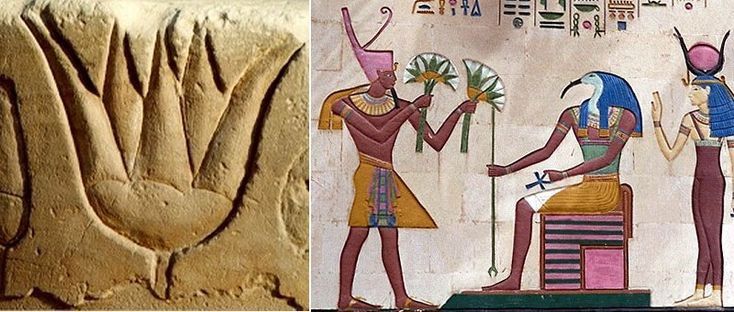The lotus flower has become a symbol in Eastern Buddhist art. It symbolizes mysterious beauty, and purity. In Egyptian, The lotus flower is a symbol of divine creation and birth - something that was highly revered in ancient Egypt, where it has played an important part in the culture for centuries. The captivating beauty of this delicate blossom and its spiritual meanings make it a popular motif for art, jewelry, tattoos, and even home décor. Whether you're researching its rich mythology or plan to incorporate it into your next design project, let's explore the intricacies of the enigmatic Egyptian lotus flower to understand why so many cultures across time have been inspired by such an awe-inspiring blossom.
1. The Mysterious Origin of the Lotus Flower
Anyone looking at Egyptian culture could not fail to notice the importance of the lotus in their culture. In ancient Egypt, there were two types of large lotus, white (Nymphaea ) and blue (N. Caerulea); pink lotus was introduced from Persia into Egypt during the late period of their civilization. The lotus was believed to be the cradle of life from which all other plants sprang forth. The earliest known depictions of the lotus date back to 3000 BC and can be found in the temples of Karnak, Luxor, and Thebes.
The Egyptians believed that the gods created the world from a giant lotus flower that emerged from the primeval waters of chaos. This sacred plant was seen as a symbol of creation and regeneration, with its petals representing the four cardinal points within the sacred circle of life. The lotus was also associated with the sun god Ra, who was said to have emerged from a lotus blossom in the morning and to have returned to it at night.
2. Sesen - Symbols in ancient Egypt
2.1. The Egyptian Lotus as a Symbol of Immortal Life
The lotus was seen as a symbol of rebirth and regeneration, as its life cycle begins anew each day. It held great spiritual significance, embodying the Egyptian ideals of eternity and resurrection. Lotus symbolism is a hallmark of religious expression in pharaonic Egypt and permeates most temple complexes and mortuary sites of pre-Christian origin. Some of Egypt’s earliest written records make direct reference to the plant, many appearing in early mortuary chambers of the Old Kingdom dynasty at Saqqara, particularly those of King Unas (ca. 2375–2345 BCE). A compilation of these hieroglyphic records with English translations in “The Ancient Egyptian Pyramid Texts'' (Faulkner 1969) is replete with mythical references to the first living being to emerge from the life-giving waters of ancient Egypt, this being the Nilotic blue lotus.
Here the lotus flower is mythically identified with the sun, a divine serpent, a blue raptor, and a solar barge, all of which motifs echo earlier Heliopolitan themes and ostensibly reflect the solar aspect of water lily blossoms: the serpentine nature of water lily peduncles, the feathery features of the plant’s large petals, and the flower’s tendency to float on water like a blue-petalled, sun-like boat (McDonald 2002).
The use of lotus imagery to symbolize eternal life was a standard practice in pharaonic Egypt and successive dynasties were recurrently identified specifically as reincarnations of Horus during their reigns as pharaohs and incarnate spirits of Nefertum, Osiris, and the Nilotic lotus in the afterlife. It was widely believed that upon the death of a pharaoh, each sovereign was bound to arise as a lotus flower “at the nose of Ra'' within the paradisal “Fields of Peace” on the Nile (=“Fields of Offerings,” “Underworld” or “Hidden Place” in the Book of the Dead, Table 1, l. 6; (Budge [1925] 1989, p. 319; Budge [1904] 1969, vol. 1, p. 170)).
This optimistic expectation was often represented in the visual arts by the image of an aristocrat, priest, or deity upholding a lotus bloom before his or her nose, as though the sweet-smelling essence of the Nilotic lotus was a source of his or her eternal life. The same general idea is communicated among the early inscriptions of King Unas at Saqqara, which equate the pharaoh with deified lotus shoots, solar orbs, and serpent gods, as noted in the aforementioned translation of Brugsch from Denderah as well as numerous Pyramid Texts (Table 1, l. 7) and funerary papyri known to modern Egyptologists as the Coffin Texts (Table 1, l. 8). Needless to say, Egyptian allusions to an immortalizing plant that bears close relations to the sun and a divine serpent foreshadow mythic themes that relate to various Middle Eastern cuneiform texts and Biblical references to the tree of life (McDonald 2002; Pritchard 1969).
2.3. Symbol for the unification of the two Egyptian kingdoms
The lotus flower has become a unifying symbol between Upper and Lower Egypt, representing the unification of both regions in ancient Egyptian culture. The two most common floral motifs of ancient Egypt through most of its time were papyrus sedge, representing Lower Egypt, and the blue lotus representing Upper Egypt. Thus, the image of Lotus and Papyrus growing together and connecting together becomes a symbol of the union of the two kingdoms. In ancient mathematics, the lotus symbol also represented the number 1000. It was also a symbol of Upper Egypt and represented the resurrection of Isis.
2.4. Flowers of the Gods
The lotus flower was a revered symbol in Ancient Egypt, appearing on pillars, tombs, thrones, and headdresses of the divine pharaohs. It decorated temples and monuments dedicated to the gods, while its representation could be found among Hieroglyphics written on papyrus scrolls. If you look at many figurative paintings, it is easy to see that the blue lotus is the most depicted picture. The blue lotus was often offered to the goddess Hathor by the Egyptians. This deity is depicted always appearing with the disk of the Sun and the horns of a bull on his head.
Many women in Ancient Egypt wore depictions of Heqet (as a frog sitting inside a lotus) around their necks during labor and childbirth, believing it would bring them luck and successful delivery. Heqet was often associated with the lotus due to its symbolizing rebirth and fertility. The goddess is sometimes depicted sitting inside a lotus flower, which further serves to emphasize her connection to these themes. The Egyptians used the flowers as offerings for their gods, and they were even placed in tombs to ensure safe passage into the afterlife. Because of its deep spiritual symbolism, the lotus flower became an integral part of Egyptian culture and religion. This symbol of rebirth and regeneration captured the imagination of the Egyptians, highlighting its importance in their culture and religious practices.
3. Roles in the funeral of the lotus
Ancient Egyptians believed that the lotus flower had great spiritual significance, particularly in relation to death and rebirth. The priests of Ancient Egypt used lotus petals as offering to their gods during religious ceremonies and rituals at temples or tombs. They also placed them in burial chambers alongside other funeral offerings like food or jewelry, believing they could help guide the deceased to the afterlife. In addition, the lotus was often featured prominently on maps of the underworld that were drawn on tomb walls.
Lotuses were also commonly included in rites of passage ceremonies, such as weddings or funerals. During these events, the petals were placed in special containers designed to hold them and paraded around town accompanied by music and dance. This was believed to help ensure the transition of the spirit from one life stage to another.
4. The Bottom Line
The lotus flower is still a symbol of rebirth and eternity in many cultures today. Although its use has evolved over time, its spiritual significance remains strong in Ancient Egypt. It serves as an important reminder of how powerful symbols can be in creating meaningful connections between people and their environment. In India - the cradle of Buddhism, the image of a lotus rising in the middle of a swamp is considered a symbol of spiritual strength and human moral values. So far, lotus is quite popular in the world, especially in Eastern countries. This image appears in most cultural and religious events, present at many life events such as birthdays, holidays, grand openings, and weddings.
Related articles
Show moreSource
1. Influences of Egyptian Lotus Symbolism and Ritualistic Practices on Sacral Tree Worship in the Fertile Crescent from 1500 BCE to 200 CE
https://www.mdpi.com/2077-1444/9/9/256
2. The Lotus and the Boat: Plutarch and Iamblichus on Egyptian Symbols*
https://muse.jhu.edu/article/819765
3. Symbolism: nymphaea flowers in pharaonic Egypt - July 2009
https://academic.oup.com/jxb/article/60/9/2461/514910







